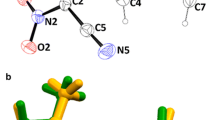Summary.
The results of the theory of the anisotropy of optical activity (ACD), especially of the circular dichroism (CD), in view of its application to the exciton chirality method was presented. In order to introduce the phenomenology some typical experimental anisotropy effects of the ACD of a dibenzoate and two taddoles were discussed. The CD and ACD of unbridged and bridged 1,1′-binaphthols were described taking into account results of the polarized spectroscopy. Their CD and ACD spectra were decomposed into contributions of their two exciton transitions. It was proven that the electric dipole/electric quadrupole transition moments contribute in same order of magnitude as the electric dipole/magnetic dipole transition moments to the tensor coordinates of the CD tensor for a bridged 1,1′-binaphthol. The CD tensor coordinates Δɛii* for a light beam propagation along the principal axes of the order tensor of a 1,1′-binaphthol of approximately C2 symmetry are very different in size and also of different sign. The largest tensor coordinate belongs to the direction along the naphthyl–naphthyl bond. The CD along the C2 symmetry axis is approximately zero. The CD tensor coordinates of different sign along different directions within a molecule can be assigned to different helicities in their molecular structure along these directions. For (R)-1,1′-binaphthol skeleton the left handed helix along an axis, which is perpendicular to the naphthyl–naphthyl bond and perpendicular to the C2 symmetry axis, leads to a positive couplet whereas for the right-handed helix along the naphthyl–naphthyl bond a negative couplet has been found. Thus, the ACD with its determination of the Δɛii* allows to observe different helicities along different directions within a molecule. As well for the bridged as the unbridged binaphthols in the spectral region of the exciton bands a third transition not belonging to the exciton band system was detected.
Similar content being viewed by others
Author information
Authors and Affiliations
Corresponding author
Rights and permissions
About this article
Cite this article
Kuball, HG., Dorr, E., Höfer, T. et al. Exciton Chirality Method. Oriented Molecules – Anisotropic Phases. Monatshefte für Chemie 136, 289–324 (2005). https://doi.org/10.1007/s00706-005-0282-2
Received:
Accepted:
Published:
Issue Date:
DOI: https://doi.org/10.1007/s00706-005-0282-2




